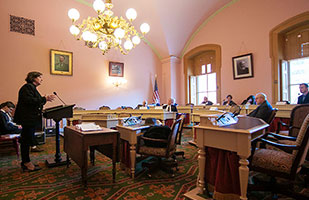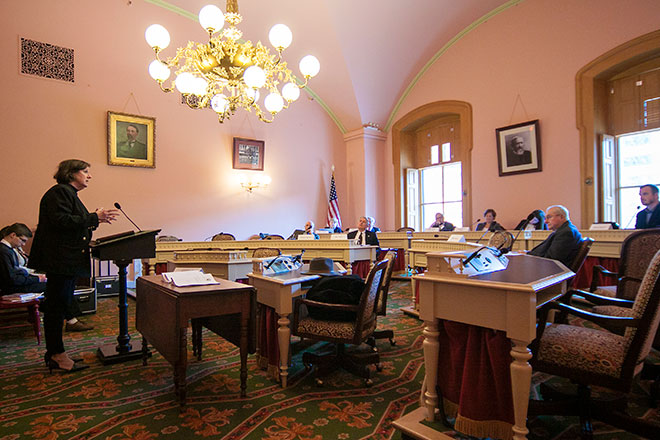Chief Justice O’Connor Asks State Constitution Commission to Consider Moving Judicial Elections to Odd Years

Chief Justice Maureen O’Connor presents her plan to improve judicial elections to members of the Ohio Constitutional Modernization Commission.

Chief Justice Maureen O’Connor presents her plan to improve judicial elections to members of the Ohio Constitutional Modernization Commission.
Ohio judicial races get lost compared to more heavily funded and media driven presidential, and gubernatorial campaigns, but are no less important to Ohioans, Ohio Supreme Court Chief Justice Maureen O’Connor told a statewide commission Thursday.
Speaking to the Ohio Constitutional Modernization Commission’s Judicial Branch and Administration of Justice Committee Thursday, Chief Justice O’Connor laid out a three-point proposal to strengthen the judicial election process, with one point requiring changing the state constitution to move all judicial elections to odd years.
The chief justice noted that judicial candidates are placed at the end of the ballot and when running in even years, they are on the same ballot as presidential candidates, other state executive branch candidates and General Assembly candidates that get higher billing. She said the research indicates the voters in those elections do not continue to make candidate selections all the way through, and drop off of judicial candidates is historically near 25 percent but has peaked to a high of 40 percent in some counties.
“We need to make the judges more visible to Ohio voters and also demonstrate that they are no less valued or no less important than races in the legislative and executive branches,” she told the committee.
Chief Justice O’Connor appeared before the Commission once before in August 2013 and noted she had an eight-point reform plan at the time. Saying she is a realist, she has dropped her recommendations to three, and only changing judicial elections year would require a constitutional change. The Modernization Commission has been studying and taking suggestions on a number of ideas, and intends to present a comprehensive package of suggestions in the future to General Assembly. State lawmakers have the authority to present the changes to voters who must approve changes to the constitution.
In addition to moving the elections, the chief justice proposed increasing the number of years of legal practice necessary to run for or be appointed to a judgeship from the current six years for all offices to more years. While not specifying a preference for a certain number, she noted past proposals requiring eight years for common pleas court, ten years for appeals courts and 12 years for supreme court justices have been proposed and seem reasonable. She said this could be changed by legislation.
Her final proposal was to increase voter education about judicial elections and judicial candidates. She said research has revealed the level of knowledge and understanding about the judiciary among the general public is inadequate and voters have said they do not have easy access to quality information.
Working with the Ohio State Bar Association, the League of Women Voters of Ohio, and the Bliss Institute of Applied Politics at the University of Akron, the Supreme Court will help develop the first statewide judicial voter education and outreach program.
“The program I envision will for the first time provide voters statewide with a website that will be a one-stop-shop for quality information about the candidates for judge at every level,” Chief Justice O’Connor said.
The Bliss Institute would oversee the website and gather candidate information. It would work through traditional and social media as well as sources to help provide more information to voters. The details of how to collect and present the information is still in the works, she noted.
“When taken together with my proposal to move judicial elections to separate years and up to the top of every ballot, the result will be more citizens voting for judge and doing so in an informed way,” Chief Justice O’Connor said.
State Rep. Michael Curtin, a committee member, noted the odd-year elections have historically lower voter turnout than presidential and gubernatorial years. He suggested if the intent is to increase the number of citizens voting for judges then using the off years would not achieve that because fewer voters turn out.
Chief Justice O’Connor responded that a change would not immediately increase voter turnout and a cultural change would occur over time. She pointed out that when women originally received the right to vote, the number of women voting did not immediately jump dramatically, but occurred over time. If given the chance, the odd-year elections would become thought of as the “judicial year” elections and turnout would increase.
As she presented her changes, the chief justice stated Ohioans continue to receive a great deal of misinformation about judges and the courts and believe that judges are influenced by politics and by campaign contributions. Committee members asked her if she favored proposals to add political affiliations to the judicial candidates like the other candidates and if she supported public financing of judicial races to reduce reliance on campaign contributions.
Chief Justice O’Connor said the party label would be a “miscue” to voters since the role of judges is to be independent and their work does not readily match itself to party ideology. She said judicial candidates are permitted to advertise their party affiliation, but it should not be on the ballot. She suggested that public financing in other states has not worked effectively because special interest group can advertise and influence elections and are not bound to any limits in campaign spending.
Asked directly by committee member Dennis Mulvihill if the problem with the Ohio judicial election system is that judges are influenced by campaign contributions, the chief justice rejected the notion.
“I think it is a perceived problem. But I don’t believe a judge in Ohio would consider who their contributors are when they make their decisions,” she said.
Mulvihill proposed, and the chief justice concurred, that contributors make donations because they share the judge’s judicial philosophy and over all views on the role of a judge.
Committee Chair Janet Abaray said the groups will continue to take recommendations under advisement and report their proposed changes to the overall commission.


